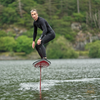Wetsuit Buoyancy and Its Impact on Swimming Technique

Swimming is a physically demanding activity that requires a delicate balance between technique, strength, and efficiency. Over the years, advancements in swimwear technology have led to the development of wetsuits, which play a significant role in enhancing buoyancy and affecting swimming technique. Whether you're a competitive athlete, a recreational swimmer, or a triathlete, understanding the relationship between wetsuit buoyancy and swimming technique can significantly improve your performance in the water.
-------
The Science of Buoyancy:
Buoyancy refers to the upward force exerted on an object submerged in a fluid, such as water, due to the difference in pressure between the top and bottom of the thing. This force counteracts the effect of gravity, causing the object to float or feel lighter in the fluid. In the context of swimming, buoyancy directly impacts body position and overall hydrodynamics.
Wetsuits are designed with specific materials that trap a thin layer of water between the suit and the skin. This layer is then warmed by body heat, creating an insulating effect. Additionally, wetsuits are made from neoprene, a highly buoyant material. The combination of the insulating water layer and the positive material contributes to increased buoyancy, lifting the swimmer's body and altering their position in the water.

Effects on Swimming Technique:
- Improved Body Position: One of the most notable effects of wetsuit buoyancy is improving body position in the water. A wetsuit elevates the swimmer's hips and legs, allowing for a more horizontal orientation in the water. This streamlined position reduces drag and the resistance encountered while moving through the water. With reduced drag, swimmers can move more efficiently and with less effort.
- Reduced Resistance: Wetsuits also help reduce the resistance created by the human body's natural buoyancy points. These points include the head, shoulders, hips, and knees. By elevating these points, a wetsuit minimizes the frontal area exposed to the water, resulting in decreased resistance as the swimmer moves forward.
- Enhanced Stability: Wetsuits provide additional stability to swimmers by preventing excessive rolling or side-to-side movement. This stability can be particularly beneficial in open water swims where currents and waves challenge a swimmer's balance.
- Increased Propulsion: Wetsuit buoyancy can indirectly contribute to increased propulsion. When the swimmer's body is positioned more horizontally, drag can be minimized. All of that energy spent on overcoming drag is reduced. Allowing swimmers to allocate more energy to generating forward momentum.

Considerations and Techniques:
While wetsuits offer numerous advantages, it's essential to acknowledge that their impact on swimming technique is unique for all swimmers. Individuals with different body shapes, sizes, and swimming abilities may experience varying degrees of benefit from wetsuit buoyancy.
To make the most of wetsuit buoyancy, consider the following techniques:
- Practice: Regular practice in a wetsuit is essential to adapt to the changes in body position and movement. Familiarity with the wetsuit's impact on your body can help you optimize your technique.
- Breathing: Focus on maintaining proper breathing technique. The wetsuit buoyancy can affect the body's alignment, potentially influencing breathing patterns. Practice breathing bilaterally to ensure even muscle engagement.
- Core Engagement: While wetsuits provide buoyancy, engaging your core muscles for stability and control is still important. A strong core helps maintain proper body alignment and efficient movement.
- Triathlon Transitions: For triathletes, efficient wetsuit removal during transitions is crucial. Practice removing the wetsuit quickly and smoothly to minimize time lost during the changeover.

Buoyancy isn't for everyone. Neither are wetsuits.
Despite the benefits of wetsuit buoyancy, there are specific scenarios in which swimmers might opt for a less buoyant wetsuit or choose not to use one. Over reliance on wetsuit buoyancy can lead to losing natural body awareness and proprioception in the water.
Some swimmers, particularly those with solid swimming backgrounds, may prefer a wetsuit with lower buoyancy to maintain a closer connection to the water, allowing them to rely more on their finely tuned technique and muscle engagement.
For breaststroke swimmers, buoyancy can be a disadvantage due to the legs generally being deeper in the water. Individuals who swim breaststroke regularly in a thicker wetsuit complain of lower back pain. This style of swimmer would benefit from a lower buoyancy wetsuit.
Moreover, athletes participating in races with warmer water temperatures might find that excessive buoyancy can cause discomfort or restrict their freedom of movement. Ultimately, the decision to use a buoyant wetsuit or one with less buoyancy is influenced by individual preferences, swimming style, and the specific conditions of the swim.

Conclusion:
Wetsuit buoyancy is a valuable tool that can significantly impact swimming technique. By enhancing body position, reducing resistance, and increasing stability, wetsuits offer swimmers the opportunity to improve their performance in competitive and recreational swimming settings. However, it's important to remember that wetsuits are just one component of effective swimming. Combining buoyancy benefits with proper technique and training will lead to a more proficient and enjoyable swimming experience.




